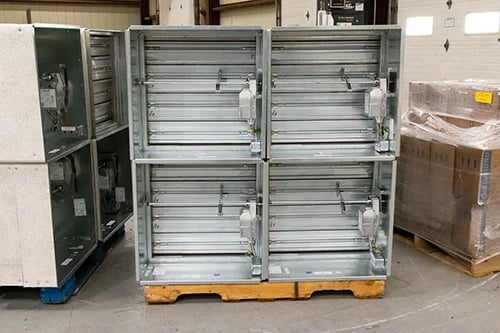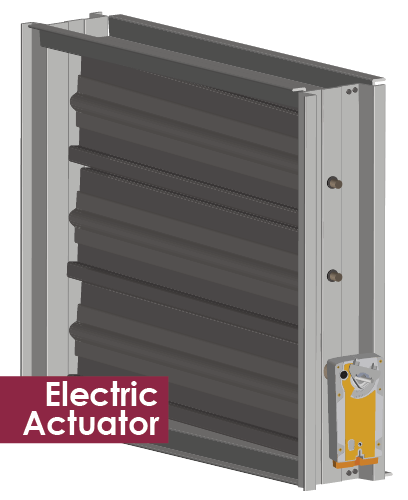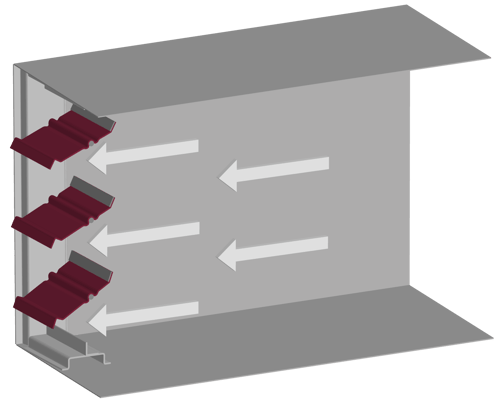Dampers are one part of an efficient HVAC system, which conserves energy and saves money. In this article, we cover four ways to make efficient dampers.
Damper Efficiency in HVAC Design
Dampers keep air running through your ductwork. They direct air to where it needs to go and help balance pressure at key points throughout the HVAC system. Airflow has a long way to travel, especially in large office buildings. Efficiency is key when it comes to designing for HVAC.

To conserve energy, and save some money, you need to get air to where it’s needed while using the least amount of power. For that, you need dampers that perform their tasks without dragging down system performance. You need efficient dampers. Let’s discuss four ways to choose dampers for efficiency.
Starting a new project and need HVAC dampers? Check out the 517-518 steel control damper from Arrow United Industries. Contact Arrow United and let us help with your HVAC requirements!
Number 1 – Electric Actuators for Automation
.jpg?width=500&height=333&name=Damper%20Accessories%20-%20Electric%20Actuator%20(Resize).jpg)
Efficient control dampers will open and close on demand. They will use automated actuators to achieve this. Electric actuators use an electric motor to drive the rotation of adjustable blades. When tied to the driving axle, this actuator type will open and close the damper.
The unit cost for electric actuators has become cheaper over the years thanks to advances in modern technology. However, the initial installation costs can be expensive because each actuator requires a power source. You will need an electrician to professionally install these units. Read more about actuators with Actuators - Making Adjustments.
Unlike other actuator types, electric actuators have the advantage of connectivity. They can be integrated with a central control system to automate the damper's opening and closing actions. From here, control dampers can support smart HVAC equipment integrated with the system.

Modern HVAC systems utilize computers that can monitor rooms throughout the building and provide heating or cooling as conditions change. Real-time monitoring has advantages over traditional heating-cooling schedules since constant monitoring allows the system to react to room occupancy, and not just the time of day. These features are also important for controlling air flow efficiently.
Automated actuators can help establish a smart HVAC system when tied to the central computer. Dampers with electric actuators can direct conditioned air to where it’s needed, when it’s needed, and close when needed. Electric actuators turn your dampers into precision machines and help to increase their efficiency.
For more on dampers, check out these Newsstand articles:
- The Condenser - Product Spotlight: The 517-518 Series
- The Condenser - Product Spotlight: The AFD-20 Series Control Damper
- Damper Showdown - Control versus Backdraft
Number 2 – Airfoil for Air Performance
.png?width=400&height=336&name=MCDLG%20Blog%20-%20Airfoil%20Blades%20(Resize).png)
Efficient dampers pass air through their open blades with minimal drag. In the damper industry, we call that drag pressure drop: the loss in pressure as airflow passes from the face of the damper, through the free area between its blades, to the ductwork behind the damper. Your HVAC system will need to exert more power to keep air running through the ductwork. For a comprehensive list, check out our primer article on damper blades.
For control dampers, the best way to minimize pressure drop is to maximize the damper's free area when its blades are fully open. The blade profile is a crucial factor in maximizing free area. Blades features, like grooves and catches, can increase the damper's pressure drop.
.webp?width=500&height=310&name=Accessories%20-%20Airfoil%20Blade%20with%20Pinlock%20Axle%20(Resize).webp)
Airfoil blades have a flat and featureless profile that lends itself to air performance. These blades consist of two flat pieces of metal fused together to form an aerodynamic shape. The only features on the profile will be the two blade seals, one on the face side and the other on the rear side of the blade.
While open, air passes along the top and bottom of the blade with minimal resistance. A flat, aerodynamic design with minimal features makes the airfoil blade an excellent choice for efficient dampers.
Number 3 – Backdraft dampers for flow in one direction
.png?width=400&height=335&name=MCDLG%20Blog%20-%20Backdraft%20Blades%20(Resize).png)
There will be areas in your HVAC system where you need to direct air flow in one direction only. Think of the intake and exhaust points in your system. You need the air to flow one way, in or out. A standard control damper might work in these cases, but there are some things to consider.
Control dampers are quick to open and close their blades, but they require an actuator attached to the damper linkage. There is also a small window, between opening and closing, where air can pass back through the damper.
Consider using a backdraft damper for these scenarios. Backdraft dampers have specialized blades that act like flaps. The blade axle runs through the back side of the blade, instead of through its center, so that the blade will open when pushed on one side.
When air moves through the duct, in the intended direction, the backdraft blades will open to let it through. The blades will close when the airflow stops and will remain closed if air tries to pass back through. Read our article on backdraft damper for more info on these unique control dampers.

Backdraft dampers rotate their blades without an actuator. This makes them an efficient option for one-way airflow because they don't need any extra parts to perform the necessary blade action. They can also receive counterweights to assist the opening action, or resist it, depending on what the application calls for.
Backdraft dampers are available with a variety of blade types, including an airfoil style “teardrop” blade, making them an efficient damper for one-way airflow applications. Conserve power by using backdraft dampers for these situations.
Number 4 – Tight Closure, Check Air Leakage
.png?width=274&height=400&name=MCDLG%20Blog%20-%20Air%20Leakage%202%20(Resize).png)
The most efficient damper will drag down system performance if it doesn’t close tightly. Many professionals focus on air performance, but air leakage is also a key factor to consider when designing efficient dampers. No damper will close airtight, but every damper should have minimal leakage when closed.
Leaks will reduce pressure across the duct, which is needed to keep air moving through the ductwork. Leaky dampers put undue strain on the system as it tries to compensate for the loss of pressure. Read more about air leakage and its effects on your system in this article.
It's important to know the damper's performance data. Check the air leakage data on the submittal. Air leakage data is gathered from AMCA testing and will be accompanied by an AMCA Ratings Seal for Air Leakage. This data will tell you how much air will pass through the closed blades at a given static pressure. Efficient dampers should close tightly.
Focus on Requirements First
Your project will have requirements, and you should always focus on meeting them first. The next step will be designing an efficient HVAC system. The system should pass air to where it's needed with the least amount of effort. Efficient dampers conserve energy and save money overall.
Need help right away? Contact MCDLG. We are ready to help you.
.webp?width=91&height=70&name=MCDLG%20Logo%20(Resize).webp)
.webp)





